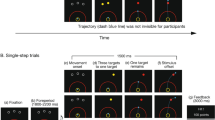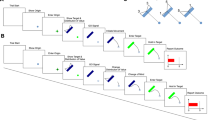Abstract
Rapid reaching movements of human and non-human primates are often characterized by irregular multi-peaked velocity profiles. How to interpret these irregularities is still under debate. While some reports assert that these irregularities are the result of a continuous controller interacting with the environment, we and others hold that the velocity irregularities are evidence for a controller that produces discrete movement corrections. Here we analyze rapid pronation/supination wrist movements in monkey during a 1D step-tracking task, where visual perturbations of the target were randomly introduced at movement onset. We use our recently introduced algorithm (Fishbach et al. in Exp Brain Res 164:442–457, 2005) to decompose an irregular movement into a primary movement and one or more discrete, corrective submovements. We first show that the visual perturbation has almost no effect on primary movements. In contrast, this perturbation influences the type and the extent of the corrective submovements that often follow primary movements. Secondly, we show that the highly variable timing of overlapping submovements does not depend directly on the visual perturbation but rather on an estimate of the movement error and on the movement’s extent-to-go at the time of correction initiation. These results are consistent with a forward-model based intermittent controller with a non-linearity that depends both on a prediction of the magnitude and direction of the movement’s error and on its variance. Corrections are initiated only when the predicted error is statistically significant. A simple abstract model that implements these principles accounts for the type and timing of the corrections observed in our data.











Similar content being viewed by others
References
Berger JO (1985) Statistical decision theory and Bayesian analysis. Springer, Berlin Heidelberg New York
Berthier NE (1996) Learning to reach: A mathematical model. Dev Psychol 32:811–823
Berthier NE (1997) Analysis of reaching for stationary and moving objects in the human infant. In: Donahue J, Dorsal VP (eds) Neural network models of complex behavior—biobehavioral foundations. North-Holland, Amsterdam, pp 283–301
Bhushan N, Shadmehr R (1999) Computational nature of human adaptive control during learning of reaching movements in force fields. Biol Cybern 81:39–60
Carpenter RH, Williams ML (1995) Neural computation of log likelihood in control of saccadic eye movements. Nature 377:59–62
Cisek P, Kalaska JF (2005) Neural correlates of reaching decisions in dorsal premotor cortex: specification of multiple direction choices and final selection of action. Neuron 45:801–814
Desmurget M, Epstein CM, Turner RS, Prablanc C, Alexander GE, Grafton ST (1999) Role of the posterior parietal cortex in updating reaching movements to a visual target. Nat Neurosci 2:563–567
Desmurget M, Turner RS, Prablanc C, Russo GS, Alexander GE, Grafton ST (2005) Updating target location at the end of an orienting saccade affects the characteristics of simple point-to-point movements. J Exp Psychol Hum Percept Perform 31:1510–1536
Engelbrecht SE, Berthier NE, O’Sullivan LP (2003) The undershoot bias: learning to act optimally under uncertainty. Psychol Sci 14:257–261
Fishbach A, Roy SA, Bastianen C, Miller LE, Houk JC (2003) Neural correlates of on-line error correction in M1 of behaving macaque monkey. In: Neural control of movement, Santa Barbara, CA
Fishbach A, Roy SA, Bastianen C, Miller LE, Houk JC (2005) Kinematic properties of on-line error corrections in the monkey. Exp Brain Res 164:442–457
Flash T, Henis E (1991) Arm trajectory modifications during reaching towards visual targets. J Cogn Neurosci 3:220–230
Ghez C, Vicario D (1978) The control of rapid limb movement in the cat. I. Response latency. Exp Brain Res 33:173–189
Glimcher PW (2003) The neurobiology of visual-saccadic decision making. Annu Rev Neurosci 26:133–179
Gordon J, Ghez C (1987) Trajectory control in targeted force impulses. III. Compensatory adjustments for initial errors. Exp Brain Res 67:253–269
Hanneton S, Berthoz A, Droulez J, Slotine JJ (1997) Does the brain use sliding variables for the control of movements? Biol Cybern 77:381–393
Harris CM (1995) Does saccadic undershoot minimize saccadic flight-time? A Monte-Carlo study. Vision Res 35:691–701
Houk JC, Fraser D, Fishbach A, Roy SA, Simo LS, Bastianen C, Wald D, Reber PJ (2006) Action selection and refinement in subcortical loops through basal ganglia and cerebellum. Philos Trans Roy Soc B (in press)
Jordan MI, Rumelhart DE (1992) Forward models: supervised learning with a distal teacher. Cogn Sci 16:307–354
Kawato M (1992) Optimization and learning in neural networks for formation and control of coordinated movement. In: Meyer DE, Kornblum S (eds) Attention and performance, vol XIV. MIT, Cambridge, p 821–849
Kositsky M, Barto AG (2001) Emergence of multiple movement units in the presence of noise and feedback delay. In: Dietterich TG, Becker Z, Ghahramani Z (eds) Advances in neural information processing systems, vol 14. MIT, Cambridge
Krakauer JW, Gordon J, Veytsman M, Ghez C (2002) Contributions of planning and updating to accuracy of reaching movements in normals and stroke. In: Society for Neuroscience, vol Program No. 169.4. 2002
Krebs HI, Aisen ML, Volpe BT, Hogan N (1999) Quantization of continuous arm movements in humans with brain injury. Proc Natl Acad Sci USA 96:4645–4649
Lee D, Port NL, Georgopoulos AP (1997) Manual interception of moving targets .2. On-line control of overlapping submovements. Exp Brain Res 116:421–433
Messier J, Kalaska JF (1999) Comparison of variability of initial kinematics and endpoints of reaching movements. Exp Brain Res 125:139–152
Meyer DE, Abrams RA, Kornblum S, Wright CE, Smith JE (1988) Optimality in human motor performance: ideal control of rapid aimed movements. Psychol Rev 95:340–370
Milner TE (1992) A model for the generation of movements requiring endpoint precision. Neuroscience 49:487–496
Milner TE, Ijaz MM (1990) The effect of accuracy constraints on three-dimensional movement kinematics. Neuroscience 35:365–374
Morasso P, Mussa Ivaldi FA (1982) Trajectory formation and handwriting: a computational model. Biol Cybern 45:131–142
Novak KE, Miller LE, Houk JC (2000) Kinematic properties of rapid hand movements in a knob turning task. Exp Brain Res 132:419–433
Novak KE, Miller LE, Houk JC (2002) The use of overlapping submovements in the control of rapid hand movements. Exp Brain Res 144:351–364
Plamondon R, Alimi AM (1997) Speed/accuracy trade-offs in target-directed movements. Behav Brain Sci 20:279–303; discussion 303–249
Pratt J, Chasteen AL, Abrams RA (1994) Rapid aimed limb movements—age-differences and practice effects in component submovements. Psychol Aging 9:325–334
Saunders JA, Knill DC (2003) Humans use continuous visual feedback from the hand to control fast reaching movements. Exp Brain Res 152:341–352
Shadmehr R, Mussa-Ivaldi FA (1994) Adaptive representation of dynamics during learning of a motor task. J Neurosci 14:3208–3224
Smith MA, Brandt J, Shadmehr R (2000) Motor disorder in Huntington’s disease begins as a dysfunction in error feedback control. Nature 403:544–549
Smith MA, Shadmehr R (2005) Intact ability to learn internal models of arm dynamics in Huntington’s disease but not cerebellar degeneration. J Neurophysiol 93(5):2809–2821
Sternad D, Schaal S (1999) Segmentation of endpoint trajectories does not imply segmented control. Exp Brain Res 124:118–136
Tunik E, Adamovich SV, Poizner H, Feldman AG (2004) Deficits in rapid adjustments of movements according to task constraints in Parkinson’s disease. Mov Disord 19:897–906
Tunik E, Frey SH, Grafton ST (2005) Virtual lesions of the anterior intraparietal area disrupt goal-dependent on-line adjustments of grasp. Nat Neurosci 8:505–511
Woodworth RS (1899) The accuracy of voluntary movement. Psychological Review 3:1–114
Acknowledgments
This work was supported by grant NS44383 to James Houk.
Author information
Authors and Affiliations
Corresponding author
Rights and permissions
About this article
Cite this article
Fishbach, A., Roy, S.A., Bastianen, C. et al. Deciding when and how to correct a movement: discrete submovements as a decision making process. Exp Brain Res 177, 45–63 (2007). https://doi.org/10.1007/s00221-006-0652-y
Received:
Accepted:
Published:
Issue Date:
DOI: https://doi.org/10.1007/s00221-006-0652-y




